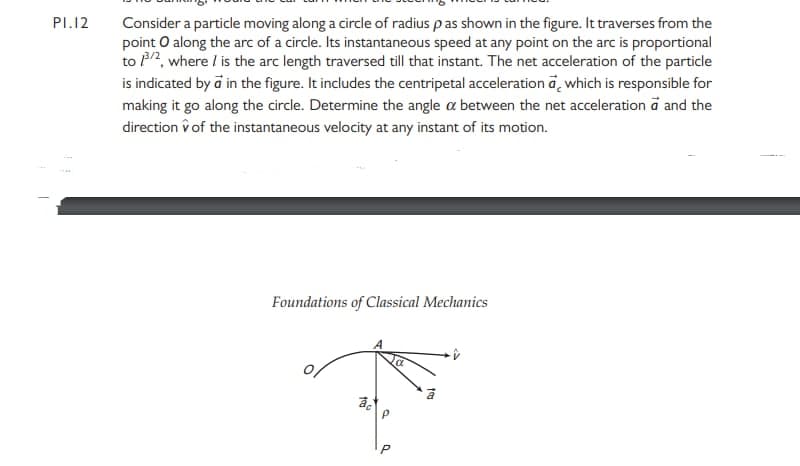Consider a particle moving along a circle of radius pas shown in the figure. It travers point O along the arc of a circle. Its instantaneous speed at any point on the arc is p to P2, where I is the arc length traversed till that instant. The net acceleration of is indicated by a in the figure. It includes the centripetal acceleration ä̟ which is resp making it go along the circle. Determine the angle a between the net acceleration direction v of the instantaneous velocity at any instant of its motion.
Consider a particle moving along a circle of radius pas shown in the figure. It travers point O along the arc of a circle. Its instantaneous speed at any point on the arc is p to P2, where I is the arc length traversed till that instant. The net acceleration of is indicated by a in the figure. It includes the centripetal acceleration ä̟ which is resp making it go along the circle. Determine the angle a between the net acceleration direction v of the instantaneous velocity at any instant of its motion.
Principles of Physics: A Calculus-Based Text
5th Edition
ISBN:9781133104261
Author:Raymond A. Serway, John W. Jewett
Publisher:Raymond A. Serway, John W. Jewett
Chapter3: Motion In Two Dimensions
Section3.5: Tangential And Radial Acceleration
Problem 3.5QQ: A particle moves along a path, and its speed increases with time. (i) In which of the following...
Related questions
Concept explainers
Topic Video
Question
I need the answer as soon as possible

Transcribed Image Text:PI.12
Consider a particle moving along a circle of radius pas shown in the figure. It traverses from the
point O along the arc of a circle. Its instantaneous speed at any point on the arc is proportional
to P2, where / is the arc length traversed till that instant. The net acceleration of the particle
is indicated by a in the figure. It includes the centripetal acceleration ä which is responsible for
making it go along the circle. Determine the angle a between the net acceleration ä and the
direction v of the instantaneous velocity at any instant of its motion.
Foundations of Classical Mechanics
Expert Solution
This question has been solved!
Explore an expertly crafted, step-by-step solution for a thorough understanding of key concepts.
Step by step
Solved in 4 steps with 2 images

Knowledge Booster
Learn more about
Need a deep-dive on the concept behind this application? Look no further. Learn more about this topic, physics and related others by exploring similar questions and additional content below.Recommended textbooks for you

Principles of Physics: A Calculus-Based Text
Physics
ISBN:
9781133104261
Author:
Raymond A. Serway, John W. Jewett
Publisher:
Cengage Learning

Physics for Scientists and Engineers: Foundations…
Physics
ISBN:
9781133939146
Author:
Katz, Debora M.
Publisher:
Cengage Learning

Classical Dynamics of Particles and Systems
Physics
ISBN:
9780534408961
Author:
Stephen T. Thornton, Jerry B. Marion
Publisher:
Cengage Learning

Principles of Physics: A Calculus-Based Text
Physics
ISBN:
9781133104261
Author:
Raymond A. Serway, John W. Jewett
Publisher:
Cengage Learning

Physics for Scientists and Engineers: Foundations…
Physics
ISBN:
9781133939146
Author:
Katz, Debora M.
Publisher:
Cengage Learning

Classical Dynamics of Particles and Systems
Physics
ISBN:
9780534408961
Author:
Stephen T. Thornton, Jerry B. Marion
Publisher:
Cengage Learning

College Physics
Physics
ISBN:
9781305952300
Author:
Raymond A. Serway, Chris Vuille
Publisher:
Cengage Learning

University Physics Volume 1
Physics
ISBN:
9781938168277
Author:
William Moebs, Samuel J. Ling, Jeff Sanny
Publisher:
OpenStax - Rice University